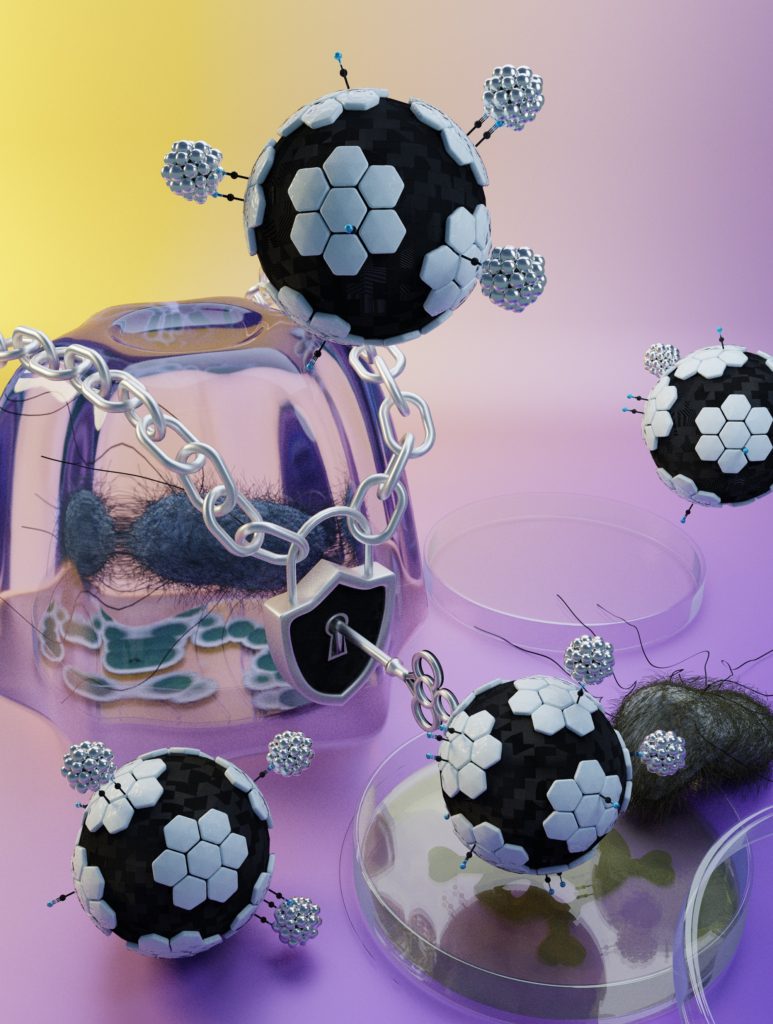Olomouc scientists developed a new way to prevent bacterial resistance
Scientists from Palacký University developed a new way to overcome bacteria’s resistance to silver nanoparticles, which are commonly used in medicine for their antimicrobial effect. A graphene derivative—cyanographene—played a major role this time round as the silver nanoparticles were bound to it by a solid bond. The scientists created a mechanical barrier that bacteria cannot overcome and therefore the effect of nanosilver is not reduced . This method has great potential in fighting harmful pathogens, particularly in local disinfection and antibacterial therapy. The work entitled Silver Covalently Bound to Cyanographene Overcomes Bacterial Resistance to Silver Nanoparticles and Antibiotics was published in Advanced Science, and made it to the cover.
The use of silver nanoparticles in modern medicine, where they support or partially replace antibiotic treatment, has progressively increased mainly due to the dramatically growing resistance of bacteria to antibiotics. Three years ago, Olomouc scientists as part of their breakthrough discovery reported that bacteria can also build resistance to nanosilver. They found that silver nanoparticles lose their antibacterial effect when they cluster into larger units—aggregates. Bacteria can attack this weak point of nanosilver by secreting a protein called flagellin, which makes the silver particles cluster into these aggregates and therefore lose their antibacterial properties. In order to solve this problem, UP scientists used chemically modified graphene.
Strong bonds form an impermeable barrier
“We managed to form such a strong bond between the chemical groups on the graphene surface and the silver nanoparticles that even the bacteria’s resistance mechanism cannot overcome. This is what makes the process so unique. We did not have to use any other chemicals, just the mechanical barrier,” said the first author of the paper David Panáček from the Czech Advanced Research and Technology Institute (CATRIN).
Thanks to calculations and simulations conducted by theoretical chemists, the scientists identified and described how the material destroys a particular bacterium by severely damaging its membrane. “We have also demonstrated that our material can be used for a wide range of bacteria that are resistant to commonly used antibiotics,” added David Panáček.
This new route is universal
In the past, UP scientists circumvented the resistance mechanism of bacteria by using natural substances. They published their work in the prestigious journal Nature Nanotechnology in 2018. At that time, they added pomegranate extracts to the silver nanoparticles, blocking the production of flagellin. This was how the aggregates of particles were prevented and bacterial resistance overcome.
“The advantage of the current solution is that the binding of nanosilver anchored to cyanographene is strong enough that the bacterial flagellin fail to make the silver nanoparticles cluster and they thus retain their high antibacterial activity. This universal approach will be effective even if bacteria manage to develop a different mechanism for nanoparticle aggregation by other chemicals than flagellin,” said Aleš Panáček from the Department of Physical Chemistry of the Faculty of Science, Palacký University.

Contribution to solving the antibiotic resistance crisis
Antibacterial products, as we know them in contemporary medicine, have been used for almost 80 years. Yet bacterial infections are still a major problem whose importance is continuoulsy increasing. Current medicine is even confronted with the real threat of losing the effect of antibiotics on bacteria and the associated ability to treat bacterial infections.
“This implies, among other things, the need to develop new and fully original antibacterial products. With this research, I believe our team is opening the door to tackling the issue of bacterial resistance to antibiotics and maintaining the ability to continue to treat bacterial infections. Equally important is the ability of the developed material to prevent infections related to artificial materials in the human body, which is important for example in the case of artificial heart valves or joint replacements. Of course, further research is needed to enable practical applications in clinical medicine,” said Milan Kolář from the Institute of Microbiology of the Faculty of Medicine and Dentistry and the University Hospital Olomouc
Silver nanoparticles are used in medicine, for example, to disinfect medical instruments, with the antimicrobial effects being used for wound or burns dressings. Scientists are also considering the possibility of adding very small amounts of nanosilver to antibiotics, thus enhancing their effects and alleviating the problem of bacterial resistance to these drugs.
“Anchored nanoparticles exhibit higher efficacy than commonly used nanosilver, while being non-toxic to human cells. In addition, the solid anchoring of nanosilver with a chemical bond prevents its eventual release into the body. We see the potential of the developed material especially in local antibacterial therapy as part of covering materials or healing creams and ointments,” concluded Radek Zbořil from CATRIN.


